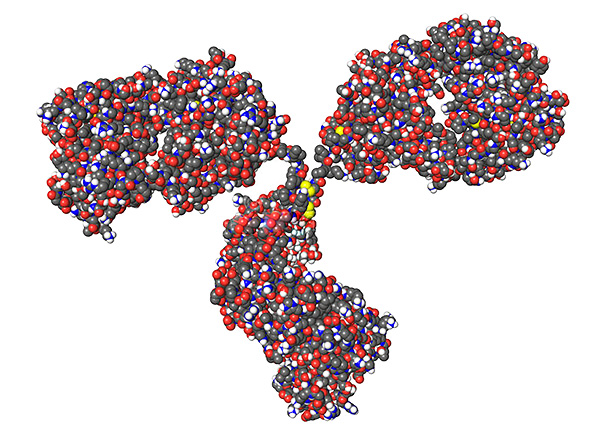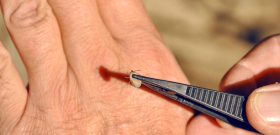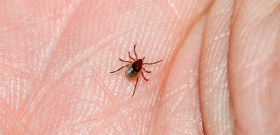
The introduction of immunoglobulin in case of a tick bite is a fairly widespread practice in Russia of emergency protection against tick-borne encephalitis. This is, first of all, relevant for people bitten in epidemiologically dangerous areas and who have not undergone preliminary vaccination. The injection is made to prevent the development of the disease and is intended to destroy the first viral particles that enter the bloodstream with the saliva of the parasite.
Immunoglobulin is used to prevent tick-borne encephalitis (but not Lyme borreliosis), as the most dangerous disease among the whole variety of tick-borne infections. Emergency injection is considered a very effective procedure, and in many cases it really helps to prevent the development of the disease, even with the simultaneous suction of several infected ticks at once. Thus, it is possible with a high probability to avoid the severe consequences of tick-borne encephalitis in those people who have not been vaccinated against it.

However, despite the seemingly indicative statistics on the decrease in the number of cases among those who receive emergency prophylaxis of TBE, immunoglobulin is not used in the West after tick bites.Next, we will figure out what this is connected with, and also see if such an injection can pose a health hazard and in which cases an injection of immunoglobulin will be practically useless ...
What is anti-encephalitis immunoglobulin and why is it needed
Immunoglobulins are proteins by their chemical nature, their other name is antibodies. They are very specific to well-defined infections and are produced by the body (namely, white blood cells) only after a collision with the corresponding pathogen.
For example, tick-borne encephalitis virus particles have a surface structure that is unique to them - it is thanks to this that the human immune system can accurately recognize this virus, and then learn how to respond specifically to its appearance. Immunoglobulins are involved in the recognition and destruction of infectious agents.
On a note
Once in the bloodstream along with the saliva of the tick, the viral particles of tick-borne encephalitis provoke a whole cascade of biochemical reactions. Receptors on the surface of blood lymphocytes recognize the antigen and begin to produce immunoglobulins that surround pathogenic particles, preventing them from multiplying and penetrating into other cells of the body.
Below is a 3D model of an immunoglobulin molecule:
Antibodies bind viruses spatially, and in addition, activate other cells of the immune system for more effective protection. The successful outcome of the fight against infection is determined by how much virus has entered the bloodstream and whether there are enough immunoglobulins that can destroy it.
See also, what exactly happens when a tick bites - the article shows what determines the amount of infected parasite saliva that gets under the skin.
It is worth noting that it takes time to develop antibodies, and at the first encounter with an infection, this process is often delayed compared to the rapid multiplication of pathogens, which is why the disease develops. To help the body cope with an infection that has got into it, patients are given an injection of ready-made antibodies, pre-concentrated and purified. Thus, the dependence on the rate of formation of one's own immunoglobulins disappears, and the chances of staying healthy when bitten by a tick infected with a virus increase dramatically.
However, no method of prevention is 100% guaranteed. According to statistics, about 20% of people with tick-borne encephalitis received timely prophylaxis, that is, they fell ill, despite the timely injection of immunoglobulin. On the other hand, in the group of patients after an emergency injection, the frequency of severe forms of encephalitis significantly decreased, yielding to milder ones.
Anti-encephalitic antibodies are obtained from the blood of vaccinated donors. When a donor is vaccinated, an "illusion" of infection is created for the immune system (by using an inactivated TBE virus), which causes the body to produce immunoglobulins in large quantities. Just at this time they can be borrowed from the blood plasma.

The drug is purified in several stages so that only a fraction of the desired proteins remains in it. Due to the fact that people are involved in the production as donors, anti-encephalitis immunoglobulin (or gamma globulin - this is the older name) is quite an expensive drug.
Human immunoglobulin against tick-borne encephalitis is used for prophylaxis in the form of a single injection, which should be carried out as soon as possible after the fact of a tick bite is established. The dose is calculated according to the weight of the patient.
On a note
Immunoglobulin injections are also used in the treatment of already developed tick-borne encephalitis, but usually in the form of a course and in completely different dosages, which increase depending on the severity of the patient's condition.
It is important to consider that anti-encephalitis immunoglobulin is a strictly specific drug that is effective only against the tick-borne encephalitis virus. For example, for the prevention of borreliosis, it will be completely useless (this disease is caused by bacteria, not viruses, and it is treated with antibiotics.) In addition, immunoglobulin is used only for humans. For example, dogs and cats are generally not very susceptible to viral encephalitis, so there is no emergency “antidote” for this infection for them.

On a note
Tick-borne encephalitis vaccine and emergency prevention of tick-borne encephalitis are not the same thing. When vaccinated, the patient's body is provoked to produce its own antibodies against the virus, while during emergency immunoprophylaxis, ready-made antibodies obtained from the blood of vaccinated donors are injected into a person. And if the vaccination is done long before the bite, then emergency prophylaxis is carried out immediately after the tick attack.
How to find out if emergency prophylaxis of tick-borne encephalitis is necessary with a tick bite
Annually due to bites ixodid ticks in Russia alone, about half a million people turn to hospitals. At the same time, only about two thousand of them fall ill. That is, the chance of becoming a victim of infection is relatively small - but this does not mean that precautions can be neglected.

It is important to note that immediately after the bite, it is impossible to find out about the fact of infection. Despite the fact that there are tests, they can determine the development of an infection no earlier than two weeks after the tick has bitten a person. The only relatively quick way to know if prophylaxis is needed is to test the tick in the lab for infection (many people hope to recognize an infected tick by appearance - see also separate article on this). How to distinguish an encephalitic tick from a common non-contagious parasite).
To check, it is better to keep the parasite alive, because it is more difficult to determine the presence of viruses in a dead tick or its fragment - the likelihood of an error increases. Thus, immediately after removing the tick, you need to place it in a jar with a tight-fitting lid and head to the nearest laboratory that performs the appropriate tests.

The result of the parasite analysis will indicate whether an emergency prophylactic immunoglobulin injection is needed. The study is not free, and sometimes you have to wait up to two or three days for the result, and delay negatively affects the effectiveness of immunoglobulin in case of infection. Therefore, people often prefer to immediately give an injection, especially if the tick bite occurred in an epidemiologically dangerous region for tick-borne encephalitis.
It should also be borne in mind that lifelong immunity after suffering tick-borne encephalitis is not formed.Therefore, even if a person has once had this disease, after a few years there is a chance of getting sick again in case of infection.
On a note
Tick-borne encephalitis cannot be contracted if the tick just crawled over the body, but did not have time to bite. In this case, you should carefully remove the parasite from the body and destroy it (it is only important not to crush it with your bare hands). It is not necessary to take a tick for analysis in such a situation.
Emergency prophylaxis of TBE must be carried out for people who were bitten in an epidemiologically dangerous area, while they did not bring a tick for analysis and did not get vaccinated against tick-borne encephalitis.
Conversely, with a bite in a region that is not dangerous for tick-borne encephalitis, or if a person has been vaccinated, there is no need to administer immunoglobulin.
Manufacturers and preparations of anti-tick immunoglobulin
The immunoglobulin against tick-borne encephalitis present on the market today is domestically produced. In Europe, its manufacture was abandoned for two main reasons. First, the entire population in TBE-endemic areas of Europe is vaccinated, and there is simply no need for anti-tick immunoglobulin. Secondly, since this drug is a protein in nature, it can cause allergic reactions, and sometimes quite severe ones. The use of such funds is associated with a certain risk, which is not always justified.
At the moment, only immunoglobulin produced by NPO Microgen can be found on sale in the Russian market. It is sold exclusively by prescription, in packs of 10 ampoules, 1 ml of solution each. The price of a full package of 10 ml in Moscow is approximately 7,000 rubles.On the box with the drug, the titer is necessarily indicated, that is, the concentration of the protein in a unit volume of the solution is expressed.

On a note
Among the components of the drug, there are only two: the human immunoglobulin itself, obtained from the blood plasma of donors, as well as the stabilizer - glycine. The manufacturer guarantees that all donors of antibodies for HIV and hepatitis C and B have been tested. The drug does not contain preservatives and antibiotics.
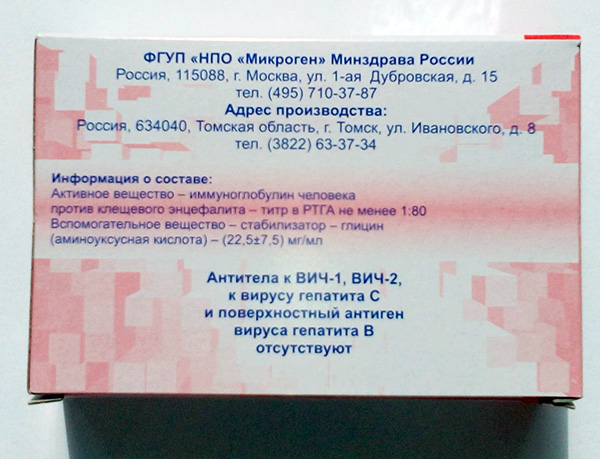
Doses and procedure for the use of immunoglobulin
For emergency prevention of tick-borne encephalitis, the dose of globulin is determined at the rate of 1 ml per 10 kg of body weight. Thus, an adult weighing 70 kg needs to be injected once with 7 ml (that is, 7 ampoules) of immunoglobulin.
The injection is always made only intramuscularly, injection into a vein is prohibited, according to the instructions for use. After removing the ampoules from the refrigerator, they are heated to room temperature before injection.
On a note
In the case when immunoglobulin is used to treat already developed tick-borne encephalitis, the dosage is calculated according to the same principle, however, injections are made for several days in a row with a certain frequency - this depends on the severity of the disease in each case.
You can store the drug only in the refrigerator, and transport it at a temperature of 2 to 8 degrees Celsius. A usable immunoglobulin solution is transparent - it can be colorless or slightly yellowish. The presence of sediment is acceptable, but it should quickly dissipate when the ampoule is shaken.If large stable flakes are visible in the solution, such a preparation is unsuitable for use - most likely, its storage conditions have been violated.
In Moscow and TBE-endemic regions, it is possible to give an injection of immunoglobulin free of charge for children under the age of 18 (in some cases up to 14 years). When a tick attack is established, adults can also receive this service at a public hospital free of charge upon presentation of a compulsory medical insurance policy. However, such a situation may arise here that the drug simply will not be in the state clinic, and you will have to contact paid medical organizations, where the cost of an injection is quite high - for example, with a body weight of 50 kg, the cost of the drug alone (without the cost of work) can be about 3500 rub.
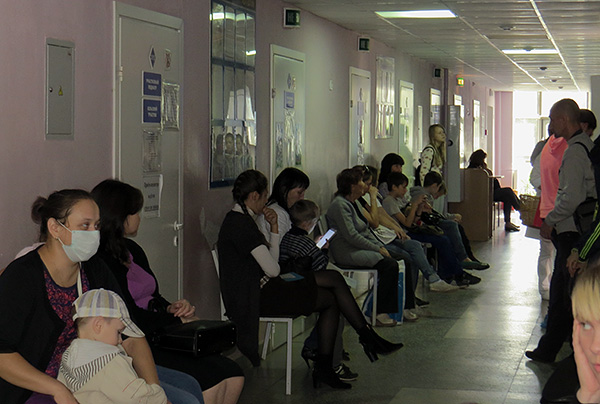
It's important to know
The more time passes from the moment of a tick bite, the less effective emergency prophylaxis will be. Four days later, it is almost useless to put immunoglobulin.
What side effects can occur after the injection
The manifestation of any side effects of immunoglobulin against TBE on the body are extremely rare. Sometimes swelling and pain at the injection site is possible for the first couple of days. This is the most common complaint of those who underwent the procedure. To avoid such reactions, the entire dose is divided into several injections, which are carried out in different parts of the body.

Usually, injections are made in the area of the gluteal muscles, forearm, as well as the external muscles of the thigh - these are the most convenient sites for injection. After the injection, an increase in body temperature up to 37-38 degrees can also be observed (usually drops to normal during the day).If the temperature persists for more than 24 hours, it is advisable to consult a doctor.
At the moment, there is no official information about an overdose of the drug: since the procedure is performed strictly in a hospital setting, and the dose is clearly calculated, there have been no cases of exceeding the dosage. The number of times in a lifetime that it is permissible to repeat injections of immunoglobulin is not limited. However, emergency prophylaxis of tick-borne encephalitis can be carried out no more than once a month (only in the treatment of tick-borne encephalitis, injections are often made).
On a note
It is extremely rare for particularly sensitive people, immunoglobulin can cause a serious allergic reaction - anaphylactic shock. This condition occurs very quickly after the injection, and in the absence of timely antihistamine therapy can lead to the death of the patient. This should be taken as seriously as possible, especially if a person knows about his predisposition to allergies. After the injection, you should not immediately leave the medical facility - it is supposed to sit here for at least 30 minutes.
You can’t take immunoglobulin ampoules with you on hikes and, moreover, give an injection outside a medical facility. Firstly, if the storage regime is violated, the drug will quickly deteriorate, and secondly, the consequences of such amateur activity can be unpredictable.
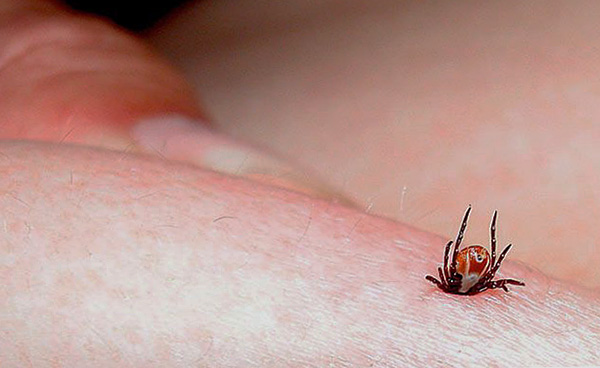
In interaction with other drugs, human immunoglobulin against TBE has no special restrictions. The only thing to refrain from for three months after the injection is immunization with serum of live viral vaccines.This is due to the excessive loading of the immune system, which needs to be given a “rest” after an anti-encephalitis injection. If you inject the drug with viral particles immediately, the body may react inadequately.
A few words about contraindications for emergency injection
There are no prohibitions strictly excluding the use of immunoglobulin against tick-borne encephalitis. Even somatic diseases in the acute phase (ARVI) are not a contraindication - the injection will still be given against the background of the main treatment. But watch the reaction of such patients especially carefully.
There are no official data from studies on the use of immunoglobulin during pregnancy and lactation, so it is prescribed with caution, weighing the possible risks and benefits for the health of the mother and child.
Alternative methods of preventing tick-borne encephalitis from a tick bite
There are several drugs that today are used with varying degrees of success as analogues or adjuncts to the injection of gamma globulin. Like an emergency injection, they cannot provide absolute protection, but some experts believe they help prevent illness.
The most popular analogues:
- Yodantipyrin is a tablet used specifically against the tick-borne encephalitis virus and hemorrhagic fever transmitted by the same ixodid ticks. The drug is named according to the active substance. The manufacturer claims that iodantipyrin has an immunostimulating effect, and also stabilizes the membranes of body cells, delaying the penetration of viruses into them.For prophylaxis after a bite, it is recommended to take a 9-day course of taking the drug, gradually reducing the dose from nine tablets per day to three. Yodantipyrin is prohibited for use in violations of the thyroid gland, as well as the liver. Its indisputable convenience lies in the fact that the reception can be carried out in the field, and the supervision of a doctor is not necessary. Some studies even claim that Jodantipyrine is more effective than an injection of immunoglobulin, but these experiments were commissioned by the manufacturer, and independent examinations have not yet been conducted. However, jodantipyrine is sometimes used today for both prevention and treatment of tick-borne encephalitis;

- Remantadine is a broad-spectrum antiviral agent. It is used less frequently than the previous drug, but has proven activity against arboviruses, to which the causative agent of tick-borne encephalitis also belongs. The active substance blocks the reproduction of viral particles, disrupting the processes of their assembly in the cells of the human body. Previously, Remantadine was actively used against influenza, but then all strains of the influenza virus developed resistance to it, and today the drug is practically ineffective against this infection. A specific regimen for the prevention of encephalitis is not indicated at all in the instructions for the drug, therefore, they are guided by the standard scheme. Remantadine should be used with caution in pathologies of the kidneys and liver, and it is also forbidden to combine it with alcohol. Reviews of experts about its effectiveness against tick-borne encephalitis are contradictory, and the medical community still does not have an unambiguous opinion on this matter;
- Separately, it is worth mentioning Anaferon, on which, with a tick bite, many pin their hopes. It is a homeopathic remedy whose manufacturers claim that it helps to stimulate the body's own immune response against infection and the production of endogenous human interferon, which protects cells from infection by viruses. In fact, the manufacturer himself does not hide the fact that the drug does not contain any specialized active ingredients, and is only a placebo. For this reason, it is unequivocally considered by professionals to be useless with respect to any viruses in principle, and because of this, it is also harmful, because when using it, people lose time on ineffective measures. But this drug is still actively promoted through advertising.
Thus, there is no reliable alternative with a proven clinical effect for emergency prophylaxis with immunoglobulin.
Is it possible to replace vaccination against tick-borne encephalitis with immunoglobulin
The main advantage of an immunoglobulin injection over vaccination is that it can be injected after a bite, and if the tick has not bitten a person, then nothing needs to be injected. But to endure all the “charms” of vaccination (sometimes you have to endure its side effects) and you have to pay money for it, regardless of whether a tick bites a person in the future or not.
The photo below shows an example of a tick-borne encephalitis vaccine Tick-E-Wak:
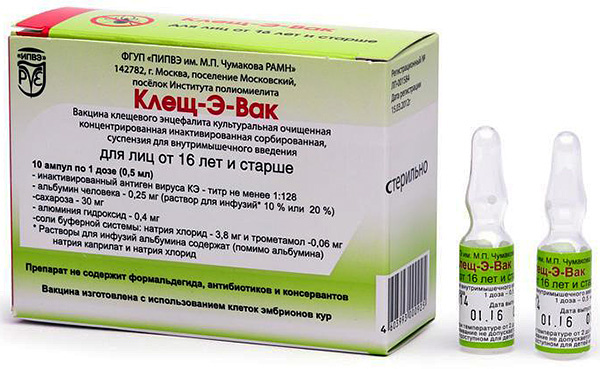
In addition, the injection of immunoglobulin is a fast-acting remedy, unlike vaccination.
On the other hand, the effectiveness of such an injection is much less than that of a vaccination carried out according to all the rules.And if you give an injection a few days after the attack of the parasite, then its effectiveness becomes negligible.
A vaccinated person may not be afraid of tick-borne encephalitis - if there is a vaccination, then the level of protection is close to 95%. Even in rare cases of encephalitis in vaccinated people, the disease proceeded easily and without consequences.
However, the obvious disadvantage of vaccination is the duration of the course. Reliable immunity is formed only a month after the second vaccination, which can be done no earlier than two weeks after the first.
On a note
If a person has been properly vaccinated, then even if bitten by an infected tick, immunoglobulin is not given. This is not necessary, since such a patient has enough of his own antibodies in the blood. Moreover, emergency prophylaxis can even harm a vaccinated person - an excess of immunoglobulins, and of different origin, can cause unwanted reactions from the immune system.
However, if the vaccination course has not been completed in full, then an injection of immunoglobulin with a tick bite can be carried out. It is also possible to use it if the vaccinated person does become ill, although such cases are extremely rare.
Be that as it may, according to the main parameter - efficiency - today there is no method of prevention that has shown itself better than vaccination. If there is enough time, then it is worth giving preference to her.
If you have personal experience of using immunoglobulin after a tick bite, be sure to share the information by leaving your review at the bottom of this page.
Useful video: first aid for a tick bite

